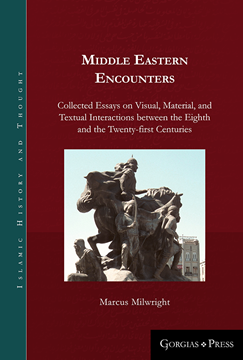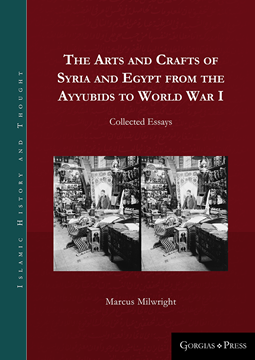Marcus Milwright

Marcus Milwright is professor of Islamic art and archaeology at the University of Victoria. His books include An Introduction to Islamic Archaeology (2010), The Dome of the Rock and its Umayyad Mosaic Inscriptions (2016), The Arts and Crafts of the Islamic World: An Anthology (2017), and The Arts and Crafts of Syria and Egypt from the Ayyubids to World War I: Collected Essays (2018).
Middle Eastern Encounters
Collected Essays on Visual, Material, and Textual Interactions between the Eighth and the Twenty-first Centuries
Series: Islamic History and Thought 21
ISBN: 978-1-4632-4193-3
This book focuses on interactions between the Islamic world and other regions from the late eighth to the twenty-first centuries. Some chapters consider the complex relationship between Islam and the cultures of Late Antiquity in the Middle East and Mediterranean basin. The reprinted chapters in this volume have been revised and updated. Topics include relief-moulded pottery production in Raqqa, the construction of palaces in Samarra, portraiture in Arabic manuscript painting, written descriptions of patterned marble in medieval Islam, images of Muslim rulers in early Modern printed books, and the broadcast of the medical examination of Saddam Hussein. Also included are a critical introduction that considers the challenges involved in the study of cultural interactions between Islamic and non-Islamic regions, a cumulative bibliography, and a previously unpublished study of recently discovered photographs, drawings, and writings relating to the Middle East made by soldiers during and after World War I.
$177.00 (USD)
The Arts and Crafts of Syria and Egypt from the Ayyubids to World War I
Collected Essays
Series: Islamic History and Thought 7
ISBN: 978-1-4632-3900-8
This book focuses on the production, sale, and consumption of portable arts in regions covered today by the modern polities of Egypt, Syria, Jordan, Lebanon, and the Palestine Authority. The reprinted chapters in this volume have been revised and updated. They offer interdisciplinary approaches to the material culture of the region from the twelfth to the early twentieth centuries, combining evidence from primary written sources, archaeology, and objects in museums and private collections. Topics include the production and distribution of pottery, importation of glazed wares into the Middle East, shadow puppetry, economic activity associated with the Syrian hajj, the manufacturing practices of the crafts operating in Damascus during the last decades of Ottoman rule, and the decoration of artillery shell cases during and after World War I. Also included are an introduction containing a critical evaluation of the main sources of information, a cumulative bibliography, and a previously unpublished study of leatherworking in the late Ottoman period.
$162.00 (USD)


